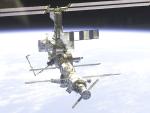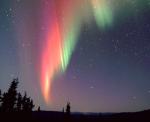
|
Astronomy Picture Of the Day (APOD)
 The Trifid Nebula from AAO
The Trifid Nebula from AAO
24.04.2002
Unspeakable beauty and unimaginable bedlam can be found together in the Trifid Nebula. Also known as M20, this photogenic nebula is visible with good binoculars towards the constellation of Sagittarius. The energetic processes of star formation create not only the colors but the chaos. The red-glowing gas results from high-energy starlight striking interstellar hydrogen gas.
 The Newly Expanded International Space Station
The Newly Expanded International Space Station
23.04.2002
What does the developing International Space Station (ISS) look like now? After delivering and deploying a crucial first backbone-like component last week, the Space Shuttle Atlantis took an inspection lap around the space station. The newly installed truss is visible toward the center of the above image.
 Comet and Aurora Over Alaska
Comet and Aurora Over Alaska
22.04.2002
Can you spot the comet? Flowing across the frozen Alaskan landscape is an easily visible, colorful aurora. Just to the lower left, however, well in the background, is something harder to spot: Comet Ikeya-Zhang, the brightest comet of recent years. Although the aurora faded in minutes, the comet is just now beginning to fade.
 The Center of Centaurus A
The Center of Centaurus A
21.04.2002
A fantastic jumble of young blue star clusters, gigantic glowing gas clouds, and imposing dark dust lanes surrounds the central region of the active galaxy Centaurus A. This mosaic of Hubble Space Telescope images taken in blue, green, and red light has been processed to present a natural color picture of this cosmic maelstrom.
 Orion Nebula: The 2MASS View
Orion Nebula: The 2MASS View
20.04.2002
Few astronomical sights excite the imagination like the nearby stellar nursery known as the Orion Nebula. The Nebula's glowing gas surrounds hot young stars at the edge of an immense interstellar molecular cloud only 1,500 light-years away.
 The Old Moon in the New Moon's Arms
The Old Moon in the New Moon's Arms
19.04.2002
Also known as the Moon's "ashen glow" or "the old Moon in the new Moon's arms", Earthshine is Earthlight reflected from the Moon's night side. This dramatic image of Earthshine...
 Planets in the West
Planets in the West
18.04.2002
Have you seen any bright planets lately? Chances are if you've been outside under clear skies just after sunset, then you have. Now shining in the west as bright "stars" in the night sky, are all five planets of the solar system known to ancient astronomers - Mercury, Venus, Mars, Saturn, and Jupiter.
 The Glory
The Glory
17.04.2002
Looking out the window of an airplane, you might be lucky enough to see "the glory" in the direction directly opposite the Sun. Before airplanes, the phenomenon, known to some as the heiligenschein or the Specter of the Brocken, was sometimes seen from mountaintops.
 Millions of Stars in Omega Centauri
Millions of Stars in Omega Centauri
16.04.2002
Pictured above is the largest ball of stars in our Galaxy. About 10 million stars orbit the center of this globular cluster - named Omega Centauri - as this giant globular cluster orbits our Galactic center.
 A New Truss for the International Space Station
A New Truss for the International Space Station
15.04.2002
The International Space Station (ISS) is being fitted with a backbone. During the present visit of Space Shuttle Atlantis, astronauts are installing a huge truss on the growing space outpost. The truss is over 13 meters long and about 4.5 meters wide.
|
January February March April May June July August September October November December |
|||||||||||||||||||||||||||||||||||||||||||||||||